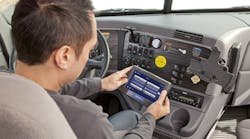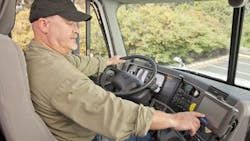As the electronic logging device (ELD) final rule issued by the Federal Motor Carrier Safety Administration (FMCSA) is gradually dissected, small but key details are bubbling to the surface.
Tom Cuthbertson, VP of regulatory compliance for Omnitracs, illustrated some of the rule’s facets in a webinar this week, noting in particular that model year 2000 and older trucks are exempted from the electronic control module (ECM) tie-in with ELDs mandated within the new rule.
“There is nothing that says you cannot use ELDs on pre-2000 model trucks,” Cuthbertson said. “ECMs showed up regular basis [on engines] starting in 1996. We hooked into ECMs back then. So the rule doesn’t say you can’t put in ELD. You can use one; it’s just allowing an exemption.”
He added that many suppliers filed comments concerned about the cost of linking mechanical engine comments to ELDs, as there would be increased costs to record odometer mileage plus “a lot” of re-calibration required for such older engines, too. “They [the FMCSA] did not want to go there,” Cuthbertson noted.
He also stressed that even when fleets have ELDs, their drivers will still be required to carry blank paper logbooks. Cuthbertson added that many “on duty” activities that cannot be recorded by ELDs still need to be accounted for in the driver’s work day log, such as safety meetings. “They still must be recorded as an on-duty activity,” he said.
One ticklish issue revolves around so-called “unassigned” truck moves, such as: maintenance technicians conducting vehicle road tests; “yard moves” governing activity in and around freight terminals and parking lots; and “personal conveyance” status for drivers.
“The ELD is required to maintain GPS once per hour while in motion and [record] GPS at every log in/log out point, capturing both location and direction information,” Cuthbertson said.
“Yard moves” are a whole different category; a "manual event" drivers are allowed to use, he explained. Typically, once a vehicle exceeds 5 mph, that starts the "drive time" clock. but that doesn't apply in yard moves or when in "personal conveyance" mode.
so what about the time spend looking for parking spaces? Or shifting trailers around a freight yard?“It’s not been defined in [the rule] what a ‘yard move’ consists of,” Cuthbertson explained. “It’s a ‘manual event’ that the driver is allowed to use. We expect guidance on this within the next six months, but right now it does not say what cannot be done and does not define what can be done.”
It gets even more complicated when “unassigned” vehicle moves become involved – a situation that often occurs when drivers forget to log in or out of the ELD
“Understand: if forget to log in, that doesn’t matter; it remains an ‘unassigned vehicle move’ and must be reconciled,” Cuthbertson noted. “In the case of road test by mechanics, you have to create a ‘driver profile’ that can take that unassigned vehicle move.”
Making sure drivers log off when they complete their route for the day or evening will be critical, he stressed. “[That activity] will have to be reconciled; that becomes a manual event and the way it is right now a driver has responsibility for manual events,” Cuthbertson said.
Using a truck to travel home once a shift or route is completed is considered “personal conveyance” for the driver, but they must be off duty to do this, he emphasized.
“This part does not necessarily have anything to do with the ELD rule. Off-duty driving is personal conveyance; we’re not changing the [hours of service] rule,” Cuthbertson noted. “As long as you are not loaded and not running [with] a manifest, you can do this.”
A final point stressed in Cuthbertson’s presentation: brokers, fleets and shippers must all be careful to avoid “driver harassment.”
“You can interpret ‘harassment control’ as many ways you like, but the best way to define it is that the control of duty status is in hands of driver,” he emphasized. “The driver has the ability to edit logs like he or she should be, as well as the right to decline unassigned driver legs.”
Though delays at shipper facilities have not been specifically addressed in the ELD mandate, Cuthbertson noted that prohibition of “coercion” is paramount within them. “Don’t force a driver to take load [for] the driver coercion penalty now $16,000” per violation, he said.




